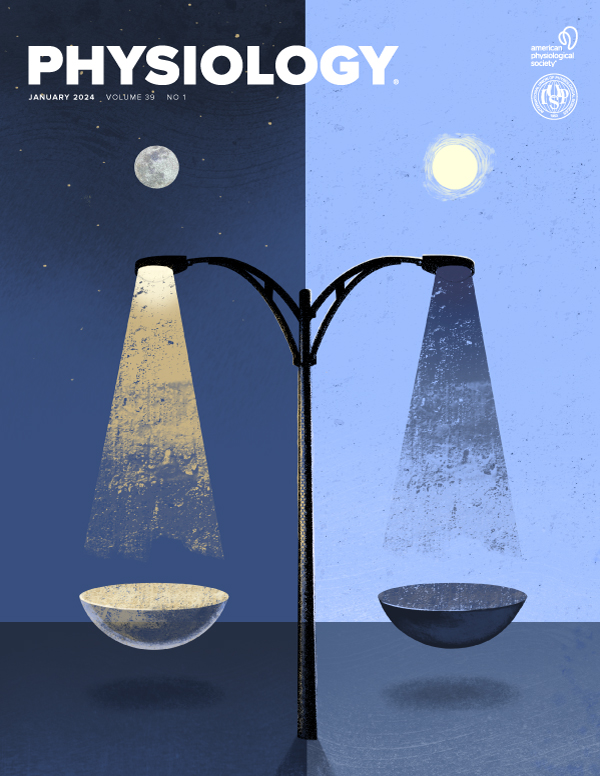锂诱导的集电管闭锁细胞胞内 Ca2+ 平衡紊乱导致小鼠代谢性酸中毒
IF 5.3
2区 医学
Q1 PHYSIOLOGY
引用次数: 0
摘要
简介。锂(Li+)是一种有效的情绪稳定剂,在现代精神病治疗中仍被广泛使用。锂(Li+)治疗最常见的不良反应之一是肾源性尿崩症,表现为尿浓缩能力下降,这是由于集合管主细胞中的血管加压素(AVP)信号传导受损所致。虽然也有报道称接受 Li+ 治疗的患者会出现远端肾小管酸中毒,但 Li+ 对集合管闰细胞和肾脏酸碱转运的病理生理效应的分子决定因素仍有待完全阐明。据报道,激活 A 间质细胞中的 Gq 偶联血管加压素 1a 受体(V1aR)可诱导细胞内 Ca2+ ([Ca2+]i)动员并刺激管腔内 H+ 分泌,从而导致尿液酸化。目的本研究的目的是检测 Li+ 是否会影响小鼠集合管闰细胞中 V1aR 诱导的[Ca2+]i 反应。假设。我们假设 Li+ 会明显损害 A 间隔细胞中依赖 V1aR 的[Ca2+]i 信号传导,从而导致集合管腔内质子分泌减少。方法:我们将新鲜分离的集合管段的免疫荧光成像与代谢笼研究相结合,在接受普通 Teklad 2918 饲粮(对照组)或含 0.3% 碳酸锂的 Teklad 2918 饲粮(Li+ 处理组)的 C57BL/6NJ (杰克逊实验室)小鼠中评估 Li+ 如何影响 V1aR 介导的 [Ca2+]i 信号、闰细胞的 H+ 转运以及尿 pH 值和氨排泄。结果。我们发现,在从对照组小鼠体内分离出的集合管段中,AVP 在水蒸发素-2(AQP2)阴性细胞中引起了短暂的[Ca2+]i 反应。这种反应是由内质网(ER)释放 Ca2+ 介导的,因为用 SERCA 泵抑制剂硫司加精(thapsigargin)预处理集合管段可抑制这种反应。从Li+处理的小鼠体内分离出的AQP2阴性细胞中,AVP诱导的钙离子瞬态的振幅降低了4倍。摄入 Li+ 显著促进了集合管细胞中的贮存操作钙离子进入(SOCE),这表明集合管细胞长期处于ER耗竭和应激状态。与对照组相比,经 Li+ 处理的小鼠全身尿液碱化(0.8 个 pH 单位),尿氨排泄量增加了 6 倍。结论。闰层细胞中的细胞内 Ca2+ 信号传导是集尿管酸碱处理的重要决定因素。我们的研究结果表明,Li+会明显改变闰层细胞中的[Ca2+]i信号传导,导致尿液碱化和铵排泄增加,这很可能是为了补偿随之而来的代谢性酸中毒。NIDDK R01DK125464。这是在 2024 年美国生理学峰会上发表的摘要全文,只有 HTML 格式。本摘要没有附加版本或附加内容。生理学》未参与同行评审过程。本文章由计算机程序翻译,如有差异,请以英文原文为准。
Lithium-Induced Disruption of Intracellular Ca2+ Balance in the Collecting Duct Intercalated Cells Contributes to Metabolic Acidosis in Mice
INTRODUCTION. Lithium (Li+) is an effective mood stabilizer that continues to be widely used in modern psychiatric practice. One of the most common adverse effects of Li+ therapy is nephrogenic diabetes insipidus manifesting in reduced urinary concentrating ability due to impaired vasopressin (AVP) signaling in the collecting duct principal cells. While distal tubular acidosis has also been reported in patients receiving Li+, molecular determinants underlying the pathophysiological effects of Li+ on the collecting duct intercalated cells and renal acid-base transport remain to be fully elucidated. Activation of Gq-coupled vasopressin 1a receptors (V1aR) in A-intercalated cells reportedly induces intracellular Ca2+ ([Ca2+]i) mobilization and stimulates luminal H+ secretion, resulting in urine acidification. OBJECTIVE. The objective of this study was to test if Li+ impaired V1aR-induced [Ca2+]i response in the intercalated cells of murine collecting ducts. HYPOTHESIS. We hypothesized that Li+ markedly impaired V1aR-dependent [Ca2+]i signaling in A-intercalated cells causing the reduction of luminal proton secretion in the collecting duct. METHODS. We combined immunofluorescent imaging in freshly isolated collecting duct segments with metabolic cage studies in C57BL/6NJ (Jackson Labotatory) mice receiving a regular Teklad 2918 chow (control) or a Teklad 2918-based diet containing 0.3% lithium carbonate (Li+-treated) to evaluate how Li+ affects V1aR-mediated [Ca2+]i signal, H+ transport by intercalated cells, as well as urinary pH and ammonia excretion. RESULTS. We found that AVP elicited a transient [Ca2+]i response in the aquaporin-2 (AQP2) negative cells from collecting duct segments isolated from control mice. The response was mediated by Ca2+ release from the endoplasmic reticulum (ER), as it was inhibited by pretreatment of collecting duct segments with thapsigargin, a SERCA pump inhibitor. The amplitude of the AVP-induced calcium transient was 4 times lower in the AQP2-negative cells isolated from Li+-treated mice. Li+ intake remarkably facilitated store-operated calcium entry (SOCE) in the collecting duct cells, indicating chronic ER depletion and stress. At the systemic level Li+-treated mice exhibited urine alkalinization (by 0.8 pH units) and a 6-fold elevation in urinary ammonium excretion, when compared to controls. CONCLUSIONS. Intracellular Ca2+ signaling in the intercalated cells is an essential determinant of acid-base handling in the collecting duct. Our findings reveal that Li+ markedly alters [Ca2+]i signaling in the intercalated cells, causing urine alkalinization and elevated ammonium excretion, likely, to compensate for ensuing metabolic acidosis. NIDDK R01DK125464. This is the full abstract presented at the American Physiology Summit 2024 meeting and is only available in HTML format. There are no additional versions or additional content available for this abstract. Physiology was not involved in the peer review process.
求助全文
通过发布文献求助,成功后即可免费获取论文全文。
去求助
来源期刊

Physiology
医学-生理学
CiteScore
14.50
自引率
0.00%
发文量
37
期刊介绍:
Physiology journal features meticulously crafted review articles penned by esteemed leaders in their respective fields. These articles undergo rigorous peer review and showcase the forefront of cutting-edge advances across various domains of physiology. Our Editorial Board, comprised of distinguished leaders in the broad spectrum of physiology, convenes annually to deliberate and recommend pioneering topics for review articles, as well as select the most suitable scientists to author these articles. Join us in exploring the forefront of physiological research and innovation.
 求助内容:
求助内容: 应助结果提醒方式:
应助结果提醒方式:


